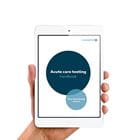Printed from acutecaretesting.org
January 2009
A comprehensive review of neonatal jaundice
Summarized from Kirk JM. Neonatal jaundice: a critical review of the role and practice of bilirubin analysis. Ann Clin Biochem 2008; 45: 452-62.
All newborn babies have, by comparison with adults, a raised serum concentration of unconjugated (and therefore total) bilirubin, due principally to the transient increase in red cell destruction associated with the move from intrauterine support to physiological independence.
In close to half of all newborns the increase in serum bilirubin is sufficient to cause jaundice. For the vast majority, this so-called "physiological" jaundice is mild and resolves spontaneously, with no long-term consequences during the first week or two of life.
However, particularly severe or prolonged jaundice is a cause for concern. In a recently published review of neonatal jaundice, a UK specialist in pediatric biochemistry addresses the physiological and clinical significance of neonatal jaundice as well as laboratory and point-of-care measurement of serum bilirubin. The article begins with a consideration of bilirubin structure along with the pathways of bilirubin production and elimination.
The physiological process that gives rise to jaundice, including the role of breastfeeding, is discussed. Pathological and clinical aspects are covered under two headings: unconjugated hyperbilirubinemia and conjugated hyperbilirubinemia. A particular focus here is the re-emergence in recent years of kernicterus and associated bilirubin encephalopathy, caused by deposition of toxic free bilirubin in the brain.
Bilirubin-lowering treatment (phototherapy) thresholds to prevent this dire outcome are discussed. Conjugated hyperbilirubinemia is less common than unconjugated hyperbilirubinemia but, no matter how mild, is always pathological; its many causes are discussed. The second half of the review is concerned with monitoring jaundice in neonates and includes a discussion of transcutaneous monitoring.
The main focus, however, is a critical assessment of methodologies used to estimate serum bilirubin concentration (both total and conjugated) in the laboratory and at the point of care. Sourced from 76 references this expert wide-ranging review is a valuable resource for all those with an interest in neonatal jaundice and bilirubin measurement in the neonate.
May contain information that is not supported by performance and intended use claims of Radiometer's products. See also Legal info.
Acute care testing handbook
Get the acute care testing handbook
Your practical guide to critical parameters in acute care testing.
Download nowRelated webinar
Cord blood gas analysis in obstetrical practice
Webinar presented by Jan Stener Jørgensen, MD PhD, Head of Obstetrics and Professor of Clinical Obstetrics, University of Southern Denmark Watch the webinarScientific webinars
Check out the list of webinars
Radiometer and acutecaretesting.org present free educational webinars on topics surrounding acute care testing presented by international experts.
Go to webinars








